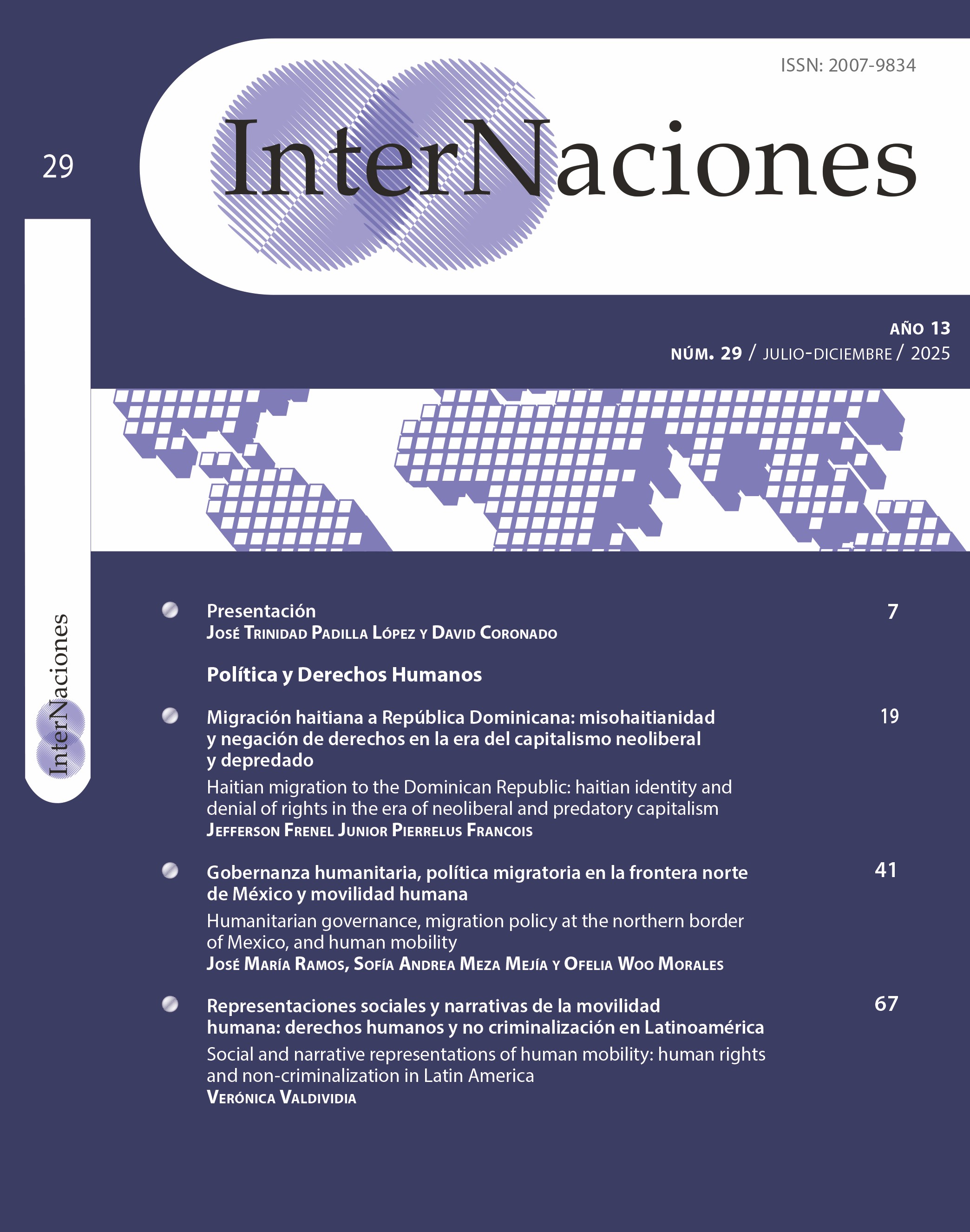La nueva gubernamentalidad necro política de las migraciones:
del régimen de deportación al régimen de desplazamiento forzado interno
DOI:
https://doi.org/10.32870/in.vi29.7302Palabras clave:
Desplazamiento forzado interno, Migración forzada, Asilo, Necropolítica, Crisis de refugiadosResumen
El artículo argumenta desde una perspectiva necropolítica –la soberanía sobre la muerte– que el régimen global de migración y asilo está pasando a ser uno de desplazamiento forzado interno. Se argumenta que los países del Primer Mundo propiciaron este cambio al cerrar y securitizar progresiva y totalmente sus fronteras a partir de 2015, al tiempo que instrumentalizaron las instituciones de administración necropolítica de la migración forzada para lograr su meta. A través del ACNUR, el Primer Mundo preparó el terreno de opinión pública y política haciendo modificaciones profundas a la metodología y la presentación de su estadística de comportamiento anual de la movilidad humana forzada. Este hecho ha justificado la producción de nuevos instrumentos legales que dificultan el asilo y la migración documentada, al tiempo que ocultan el incremento del desplazamiento interno e inflan el comportamiento esperado del refugio.Descargas
Citas
Appadurai, A. (1996), Modernity at Large: Cultural Dimensions of Globalization. University of Minnesota Press.
Benavides, L. y Patargo, S. (2012), México ante la crisis humanitaria de los desplazados internos. Foreign Affairs Latinoamérica 12 (4), pp. 77-88.
Castles, S., y Loughna, S. (2003), Discussion Paper No. 2003/31. Trends in Asylum Migration to Industrialized Countries: 1990-2001. World Institute for World Economic Research.
Castillo, M. (2018), Iván Roa: “Ecuador dejó de ser un país de paz desde hace mucho tiempo.” Ecuadortoday.com. http://www.pensamientocritico.org/ivan-roa-ecuador-dejo-de-ser-un-pais-de-paz-desde-hace-mucho-tiempo/. Publicado el 18 de junio, 2018. Consultado el 21 de agosto de 2023.
CNDH (2016), Informe Especial sobre Desplazamiento Forzado Interno (DFI) en México. México, Comisión Nacional de Derechos Humanos.
Clark, Gordon L. (1985), Judges and the cities: interpreting local autonomy. Chicago, University of Chicago Press.
De Genova, N., Mezzadra, S. & Pickles, J. (Eds.), (2014), New Keywords: Migration and Borders. Cultural Studies, 29(1), pp. 55-87.
— (2010), “The Deportation Regime: Sovereignty, Space, and the Freedom of Movement.” En, Nicholas De Genova and Nathalie Peutz (Eds.), Theoretical Overview. The Deportation Regime: Sovereignty, Space, and the Freedom of Movement,. Durham: Duke University Press.
Deleuze, G. & Guattari, F. (1987), A Thousand Plateaus: Capitalism and Schizophrenia (B. Massumi, Trans.). University of Minnesota Press.
Domenech, E. (2018), “Gobernabilidad migratoria: producción y circulación de una categoría de intervención política.” Revista Temas de Antropología y Migración (10), pp. 110-118.
Estévez, Ariadna (2025), Una metodología foucaultiana para la investigación discursiva en ciencias sociales. Intersticios Sociales. No. 30. El Colegio de Jalisco.
__ (2021a). The necropolitical production and management of forced migration. NYC, Lexington Books.
— (2021b) (Coord.), Necropower in North America: the Legal Spatialization Of Disposability And Lucrative Death, NYC, Palgrave-MacMillan.
— (2018). Guerras necropolíticas y biopolítica de asilo en América del Norte. México. CISAN-UNAM/UACM.
Foucault, M. (2008), The birth of biopolitics : lectures at the Collège de France, 1978-79. Basingstoke England ; New York: Palgrave Macmillan.
Hetq Online (12 de mayo de 2015), World Bank Responds: ‘People Not Displaced Due to Our Projects’. Hetq.com. https://hetq.am/en/article/60153. Consultado: 18 de agosto de 2023.
ICIJ (15 de abril de 2015a), Evicted & Abandoned, en Hufftingtonpost Projects. https://projects.huffingtonpost.com/worldbank-evicted-abandoned. Consultado: 18 de agosto de 2023.
— (16 de abril de 2105b), Evicted and abandoned: the world bank’s broken promise to the poor. https://www.icij.org/investigations/world-bank/explore-10-years-world-bank-resettlement-data. Consultado: 18 de gosto de 2023.
Jaskułowski, K. (2019), The Everyday Politics of Migration Crisis in Poland Between Nationalism, Fear and Empathy. Suiza, Palgrave Macmillan. 139 pp.
Jervis, R. (18 de julio de 2023), Border-crossing numbers plunge as CBP’s online app, new deportation rules take effect. Ustoday.com. https://www.usatoday.com/story/news/investigations/2023/07/17/how-cpb-one-app
deportation-rules-are-driving-down-border-crossings/70413101007/. Consultado: 21 de agosto de 2023.
Mbembe, A. (2011), Necropolítica. España, Melusina (sic).
— (2003). “Necropolitics”. Public Culture 15 (1), pp. 11-40.
Mezzadra, S. & Neilson, B. (2017), La frontera como método o la multiplicación del trabajo. Madrid, Traficantes de sueños.
Paley, D. (2014), Drug War Capitalism. Oakland: AK Press.
Plataforma por la Paz y la Justicia (14 de noviembre de 2021), Las familias desplazadas por la violencia en Guanajuato. PopLab.mx. https://poplab.mx/v2/column/Plataforma-por-la-Paz-y-la-Justicia/Las-familias-desplazadas-por-la-violencia-en-Guanajuato. Consultdo: 21 de agosto de 2023.
Robinson, A. (2020), Oro, petróleo y aguacates: las nuevas venas abiertas de América Latina. Primera edición. Barcelona, Editorial Arpa.
Rubio Díaz-Leal, L. (2014), Desplazamiento interno inducido por la violencia: una experiencia global, una realidad mexicana. México, ITAM/CMDPDH.
Samaddar, R. (2016), A Post-Colonial Enquiry into Europe’s Debt and Migration Crisis. Singapur, Springer Nature.
Seefar (septiembre de 2016), Farsight. Displaced people. What is the real crisis? The numbers behind the noise. Seefar.org. https://seefar.org/wp-content/uploads/Seefar-Displaced-People-Where-is-the-real-crisis.pdf . Consul
tado: 23 de gosto de 2023.
Squire, V. (2017), “Governing migration through death in Europe and the US: Identification, burial and the crisis of modern humanism”. European Journal of International Relations. 23(3), pp. 513–532.
UNHCR (2002), Global refugee trends. January–March 2002. Populations, new arrivals, voluntary repatriation and resettlement in some 90 countries. Geneva: United Nations High Commissioner for Refugees. https://www.unhcr.
org/statistics/unhcrstats/4173bfba4/global-refugee-trends-januarymarch-2002.html. Consultado: 23 de gosto de 2023.
UNHCR (2003), Global Refugee Trends. Overview of Refugee Populations, New Arrivals, Durable Solutions, Asylum-Seekers and Other Persons of Concern to UNHCR. Geneva: United Nations High Commissioner for Refugees. https://www.unhcr.org/statistics/unhcrstats/40d015fb4/2003-global-refugee-trends-overview-refugee-populations-new-arrivals-durable.html. Consultado: 23 de agosto de 2023.
UNHCR (2004), Global Refugee Trends. Overview of Refugee Populations, New Arrivals, Durable Solutions, Asylum-Seekers and Other Persons of Concern to UNHCR. Geneva: United Nations High Commissioner for Refugees. https://www.unhcr.org/statistics/unhcrstats/42b283744/2004-global-refugee-trendsoverview-refugee-populations-new-arrivals-durable.html. Consultado: 23 de agosto de 2023.
UNHCR (2005), 2005 Global Refugee Trends. Statistical Overview of Populations of Refugees, Asylum-Seekers, Internally Displaced Persons, Stateless Persons, and Other Persons of Concern to UNHCR. Geneva: United Nations
High Commissioner for Refugees. https://www.unhcr.org/statistics/
unhcrstats/4486ceb12/2005-global-refugee-trends-statistical-overviewpopulations-refugees-asylum.html. Consultado: 23 de agosto de 2023.
UNHCR (2006), UNHCR global trends 2006 : refugees, asylum seekers, returnees, internally displaced and stateless persons. Geneva: United Nations High Commissioner for Refugees. https://digitallibrary.un.org/record/3966507. Consultado: 23 de agosto de 2023.
UNHCR (2007), 2007 Global Trends: Refugees, Asylum-seekers, Returnees, Internally Displaced and Stateless Persons. Geneva: United Nations High Commissioner for Refugees. https://www.unhcr.org/4852366f2.pdf. Consultado: 23 de agosto de 2023.
UNHCR (2007), Asylum Levels and Trends in Industrialized Countries, 2007. Statistical Overview of Asylum Applications Lodged in Europe and Selected Non-European Countries. Geneva: United Nations High Commissioner for Refugees. https://www.unhcr.org/47daae862.pdf. Consultado: 23 de agosto de 2023.
UNHCR (2008), 2008 Global Trends: Refugees, Asylum-seekers, Returnees, Internally Displaced and Stateless Persons. Geneva: United Nations High Commissioner for Refugees. https://www.unhcr.org/4a375c426.pdf. Consultado: 23 de agosto de 2023.
UNHCR (2008), Asylum Levels and Trends in Industrialized Countries, 2008. Statistical Overview of Asylum Applications Lodged in Europe and Selected Non-European Countries. Geneva: United Nations High Commissioner for Refugees. https://www.unhcr.org/statistics/STATISTICS/49c796572.pdf. Consultado: 23 de marzo de 2023.
UNHCR (2009), 2009 Global Trends: Refugees, Asylum-seekers, Returnees, Internally Displaced and Stateless Persons. Geneva: United Nations High Commissioner for Refugees. https://www.unhcr.org/4c11f0be9.pdf.
Consultado: 23 de agosto de 2023.
UNHCR (2009), Asylum Levels and Trends in Industrialized Countries, 2009. Statistical Overview of Asylum Applications Lodged in Europe and Selected Non-European Countries. Geneva: United Nations High Commissioner for Refugees. https://www.unhcr.org/statistics/unhcrstats/4ba7341a9/asylum-levels-trends-industrialized-countries-2009-statistical-overview.html. Consultado: 23 de agosto de 2023.
UNHCR (2010), 2010 Global Trends: Refugees, Asylum-seekers, Returnees, Internally Displaced and Stateless Persons. Geneva: United Nations High Commissioner for Refugees. https://www.unhcr.org/statistics/country/4dfa11499/unhcr-global-trends-2010.html. Consultado: 23 de agosto de 2023.
UNHCR (2010), Asylum Levels and Trends in Industrialized Countries, 2010. Statistical Overview of Asylum Applications Lodged in Europe and Selected Non-European Countries. Geneva: United Nations High Commissioner for Refugees. https://www.unhcr.org/statistics/unhcrstats/4d8c5b109/asylum-levels-trends-industrialized-countries-2010-statistical-overview.html Consultado: 23 de agosto de 2023.
UNHCR (2011), A Year of Crises. UNHCR Global Trends 2011. Geneva: United Nations High Commissioner for Refugees. https://www.unhcr.org/sta tistics/country/4fd6f87f9/unhcr-global-trends-2011.html. Consultado:
de agosto de 2023.
UNHCR (2011), Asylum Levels and Trends in Industrialized Countries, 2011. Statistical Overview of Asylum Applications Lodged in Europe and Selected Non-European Countries. Geneva: United Nations High Commissioner for Refugees. https://www.unhcr.org/statistics/unhcrstats/4e9beaa19/asylum-levels-trends-industrialized-countries 2011-statistical-overview.html. Consultado: 23 de agosto de 2023.
UNHCR (2012), Displacement. The New 21st Century Challenge. Geneva: United Nations High Commissioner for Refugees. https://www.unhcr.org/statistics/country/51bacb0f9/unhcr-global-trends-2012.html. Consultado: 23 de agosto de 2023.
UNHCR (2012), Asylum Levels and Trends in Industrialized Countries, First Half 2012. Statistical Overview of Asylum Applications Lodged in Europe and Selected Non-European Countries. Geneva: United Nations High Commissioner
for Refugees. https://www.unhcr.org/statistics/unhcrstats/507c000e9/asylum-levels-trends-industrialized-countries-first-half-2012-statistical.html. Consultado: 23 de agosto de 2023
UNHCR (2013) War’s human cost. UNHCR Global Trends 2013. Geneva: United Nations High Commissioner for Refugees. https://www.unhcr.org/ph/wp-content/uploads/sites/28/2017/03/GlobalTrends2013.pdf. Consultado: 23 de agosto de 2023.
UNHCR (2013), UNHCR Asylum Trends 2013. Levels and Trends in Industrialized Countries. Geneva: United Nations High Commissioner for Refugees. https://www.unhcr.org/statistics/unhcrstats/5329b15a9/asylum-levels-trends-industrialized-countries-2013.html. Consultado: 23 de agosto de 2023.
UNHCR (2014a), World at war. UNHCR Global Trends. Forced Displacement in 2014. Geneva: United Nations High Commissioner for Refugees. https://www.unhcr.org/statistics/country/556725e69/unhcr-global-trends-2014.html. Consultado: 23 de agosto de 2023.UNHCR (2014b) UNCHR Asylum Trends 2014. Levels and Trends in Industrialized Countries. Geneva: United Nations High Commissioner for Refugees. https://www.unhcr.org/statistics/unhcrstats/551128679/asylum-levels-trends-industrialized-countries-2014.html. Consultado: 23 de agosto de 2023.
UNHCR (2015). Global Trends. Forced Displacement in 2015. Geneva: United Nations High Commissioner for Refugees. https://www.unhcr.org/statistics/unhcrstats/576408cd7/unhcr-global-trends-2015.html. Consultado: 23 de
agosto de 2023.
UNHCR (2016). Global Trends. Forced Displacement in 2016. Geneva: United Nations High Commissioner for Refugees. https://www.unhcr.org/statistics/unhcrstats/5943e8a34/global-trends-forced-displacement-2016.html. Consultado: 23 de agosto de 2023.
UNHCR (2017). Global Trends. Forced Displacement in 2017. Geneva: United Nations High Commissioner for Refugees. https://www.unhcr.org/statistics/unhcrstats/5b27be547/unhcr-global-trends-2017.html. Consultado: 23 de agosto de 2023.
UNHCR (2018). Global Trends. Forced Displacement in 2018. Geneva: United Nations High Commissioner for Refugees. https://www.unhcr.org/statistics/unhcrstats/5d08d7ee7/unhcr-global-trends-2018.html. Consultado: 23 de agosto de 2023.
UNHCR (2019). Global Trends. Forced Displacement in 2019. Geneva: United Nations High Commissioner for Refugees. https://www.unhcr.org/statistics/unhcrstats/5ee200e37/unhcr-global-trends-2019.html. Consultado: 23 de agosto de 2023.
UNHCR (2020). Global Trends. Forced Displacement in 2020. Geneva: United Nations High Commissioner for Refugees. https://www.unhcr.org/statistics/unhcrstats/60b638e37/global-trends-forced-displacement-2020.html. Consultado: 23 de agosto de 2023.
UNHCR (2021). Global Trends. Forced Displacement in 2021. Geneva: United Nations High Commissioner for Refugees. https://www.unhcr.org/publications/brochures/62a9d1494/global-trends-report-2021.html. Consultado: 23 de agosto de 2023.
UNHCR (2021). Global Trends. Forced Displacement in 2021. Geneva: United Nations High Commissioner for Refugees. https://www.unhcr.org/publications/brochures/62a9d1494/global-trends-report-2021.html. Consultado: 23 de agosto de 2023.
UNHCR (2022). Mid-year trends 2022. Geneva: United Nations High Commissioner for Refugees. https://www.unhcr.org/statistics/unhcrstats/635a578f4/mid-year-trends-2022.html. Consultado: 23 de
agosto de 2023.
Valencia, Sayak (2010). Capitalismo Gore. España, Melusina.
Zetter, R. (2007). Fewer Refugees: Remaking the Refugee Label in an Era of Globalization. Journal of Refugee Studies, 20(2), pp. 172-192.
Publicado
Cómo citar
Número
Sección
Licencia
Derechos de autor 2025 Universidad de Guadalajara

Esta obra está bajo una licencia internacional Creative Commons Atribución-NoComercial-CompartirIgual 4.0.
CC BY-NC-SA 4.0 https://creativecommons.org/licenses/by-nc-sa/4.0/


























